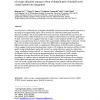Free Online Productivity Tools
i2Speak
i2Symbol
i2OCR
iTex2Img
iWeb2Print
iWeb2Shot
i2Type
iPdf2Split
iPdf2Merge
i2Bopomofo
i2Arabic
i2Style
i2Image
i2PDF
iLatex2Rtf
Sci2ools
AROBOTS
2010
2010
Reactive direction control for a mobile robot: a locust-like control of escape direction emerges when a bilateral pair of model
Locusts possess a bilateral pair of uniquely identifiable visual neurons that respond vigorously to the image of an approaching object. These neurons are called the lobula giant movement detectors (LGMDs). The locust LGMDs have been extensively studied and this has lead to the development of an LGMD model for use as an artificial collision detector in robotic applications. To date, robots have been equipped with only a single, central artificial LGMD sensor, and this triggers a non-directional stop or rotation when a potentially colliding object is detected. Clearly, for a robot to behave autonomously, it must react differently to stimuli approaching from different directions. In this study, we implement a bilateral pair of LGMD models in Khepera robots equipped with normal and panoramic cameras. We integrate the responses of these LGMD models using methodologies inspired by research on escape direction control in cockroaches. Using `randomised winner-take-all' or `steering wheel...
| Added | 08 Dec 2010 |
| Updated | 08 Dec 2010 |
| Type | Journal |
| Year | 2010 |
| Where | AROBOTS |
| Authors | Shigang Yue, Roger D. Santer, Yoshifumi Yamawaki, F. Claire Rind |
Comments (0)

